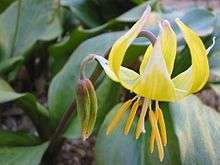Erythronium tuolumnense
| Tuolumne fawn lily | |
|---|---|
 | |
| 'Pagoda', Jardin des Plantes, Paris | |
| Scientific classification | |
| Kingdom: | Plantae |
| (unranked): | Angiosperms |
| (unranked): | Monocots |
| Order: | Liliales |
| Family: | Liliaceae |
| Genus: | Erythronium |
| Species: | E. tuolumnense |
| Binomial name | |
| Erythronium tuolumnense Applegate | |
Erythronium tuolumnense is a species of flowering plant in the family Liliaceae, known by the common name Tuolumne fawn lily or Tuolumne dog's tooth violet. However, it is neither a true lily nor a violet. It is endemic to the Sierra Nevada of Tuolumne County, California; from 600 m (1,969 ft) along Italian Bar Road up to 1,000 m (3,281 ft) altitude at the headwaters of Deer Creek.[1]
This hardy perennial wildflower grows from a bulb 5–10 cm (2–4 in) wide, sometimes with associated bulblets. The bulb resembles a dog's tooth in shape and colour, hence the name "dog's tooth" (which also applies to other erythronium species such as E. dens-canis). It produces two small leaves and a reddish stalk up to 35 cm (14 in) tall bearing one to five flowers. The flower has bright yellow recurved tepals, a white style and white stamens tipped with large yellow anthers.[1][2][3]
This rare plant is threatened by human activity such as logging in its small native range.
Inhabiting moist, light deciduous woodland, this plant is also found in cultivation. The species[4] and the hybrid cultivar 'Pagoda'[5] have gained the Royal Horticultural Society's Award of Garden Merit.
References
- 1 2 Flora of North America v 26 p 159
- ↑ Applegate, Elmer Ivan.. 1930. Contributions from the Dudley Herbarium 1(4): 153–154.
- ↑ Hickman, J. C. 1993. The Jepson Manual: Higher Plants of California 1–1400. University of California Press, Berkeley.
- ↑ "Erythronium tuolumnense". Royal Horticultural Society. Retrieved 26 July 2013.
- ↑ "Erythronium 'Pagoda'". Royal Horticultural Society. Retrieved 26 July 2013.